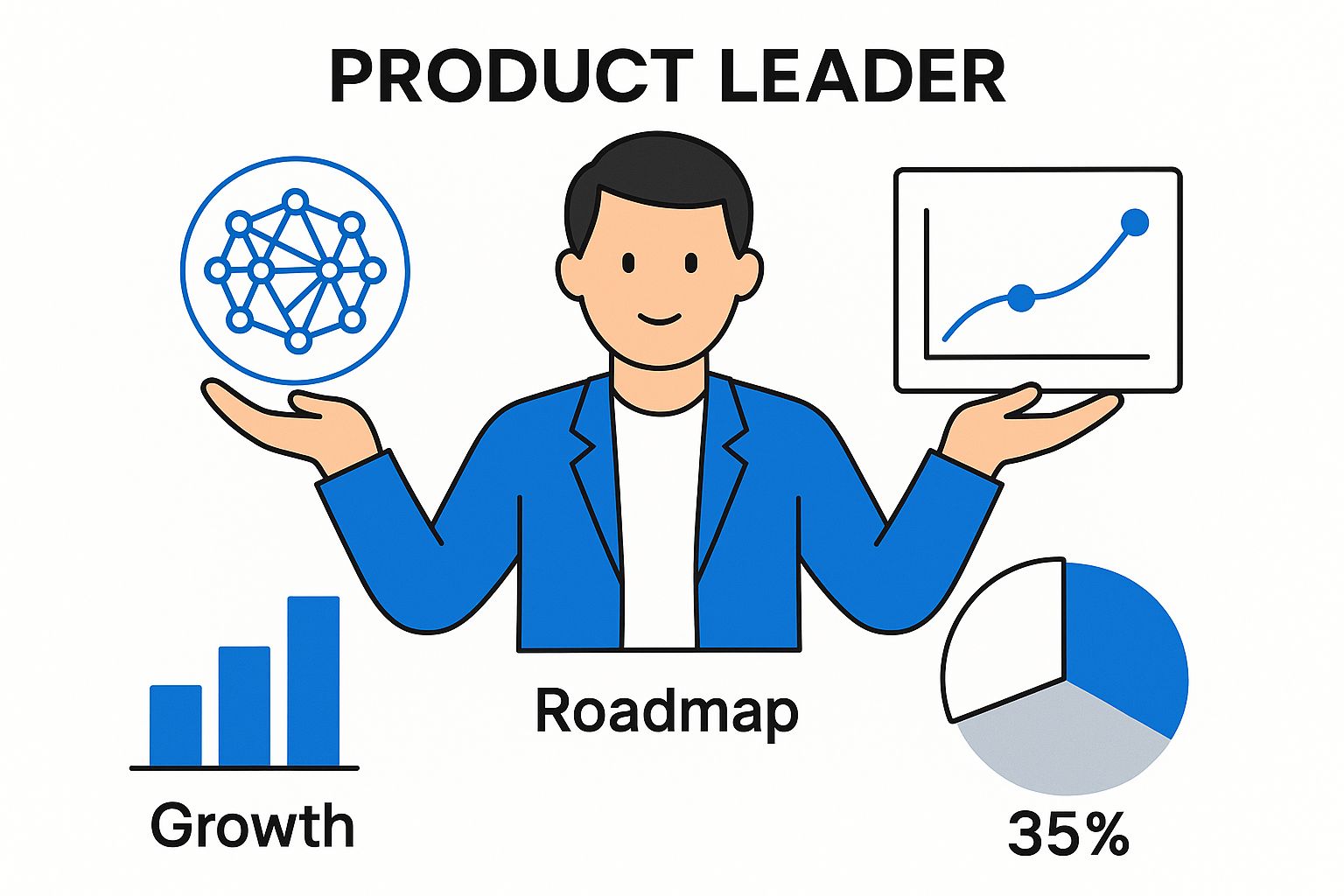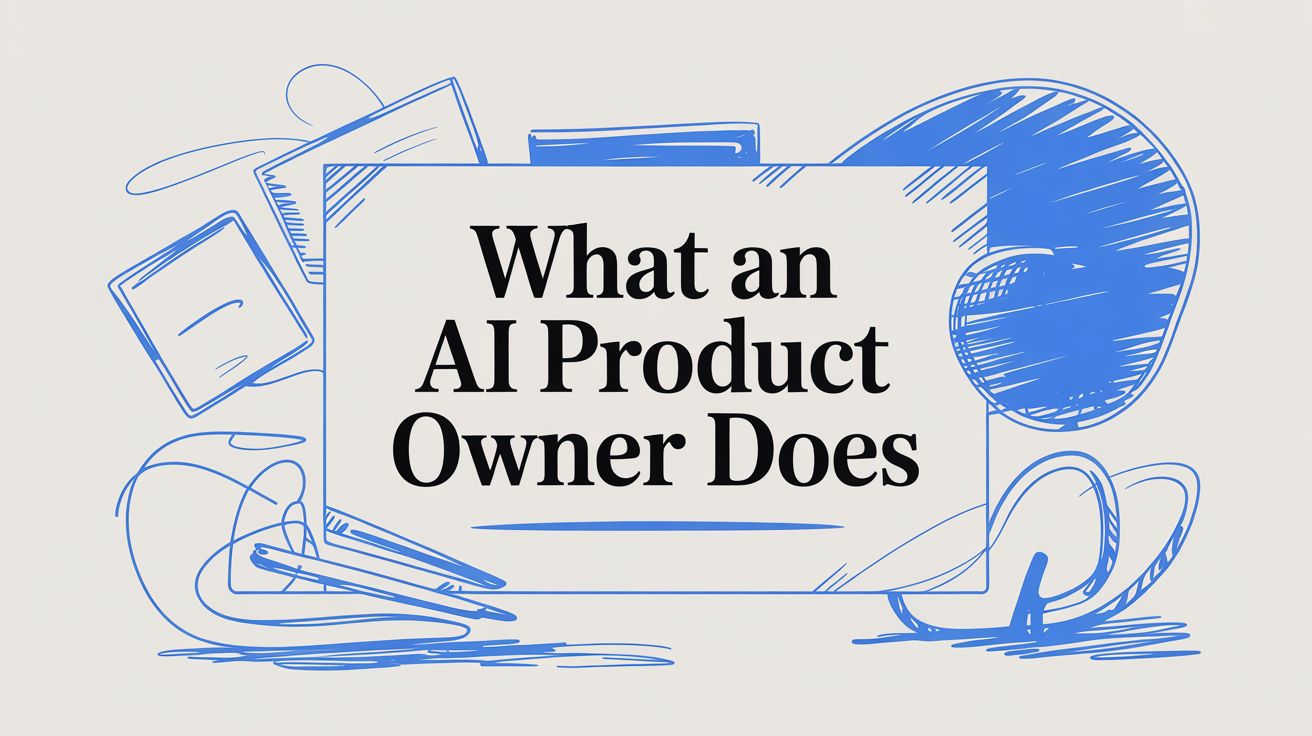An AI Product Owner is the strategic mind steering an artificial intelligence product from a rough idea all the way to a successful launch. With the global AI market projected to skyrocket from $241.80 billion in 2023 to an astonishing $1,847.48 billion by 2032, this role is no longer a niche specialty—it’s a critical leadership position at the heart of modern innovation.
This isn’t just a new label for a traditional software manager. An AI Product Owner merges sharp business acumen with the unique, often unpredictable world of machine learning, requiring a genuine understanding of data, algorithms, and probabilistic systems.
The New Frontier of Product Leadership
Stepping into an AI Product Owner role is more than a title change—it’s a fundamental shift in perspective. Traditional product management deals with deterministic systems: code that does exactly what you tell it to, every single time. It’s predictable.
AI products, on the other hand, are probabilistic. They learn from data, they adapt, and sometimes, they make decisions you didn’t anticipate.
This difference is everything. An AI product leader doesn’t just manage a neat backlog of features. They guide the development of an evolving system, overseeing the data pipelines that fuel the model, wrestling with the ethical implications of its decisions, and explaining its inherent uncertainties to stakeholders accustomed to black-and-white results.
The Shift from Features to Capabilities
A traditional PO might define a task like, “Add a button that does X.” An AI PO frames the goal as a capability: “Build a model that can predict customer churn with 85% accuracy.” This demands a totally different approach to planning—one built on experimentation and continuous improvement, not a rigid, unchangeable roadmap.
An AI Product Owner’s biggest challenge is translating ambiguous business problems into concrete, machine-learnable tasks. They must be the bridge between what the business wants and what the data science team can realistically build.
This new leadership is non-negotiable as the market continues its explosive growth. The AI sector is experiencing a compound annual growth rate (CAGR) of 36.8%, a clear indicator of the immense pressure to deliver value. This underscores the critical need for skilled leaders who can guide AI projects to success. You can explore the full analysis of AI market growth to understand the forces driving this demand.
Visualizing the AI Product Leader
The infographic below perfectly illustrates the two worlds an AI Product Owner inhabits. They have one foot planted in the strategic vision of a product roadmap and the other deep in the technical details of neural networks and machine learning.

This image captures the essence of the role: a leader who can discuss market strategy in one meeting and dive into the nuances of model performance in the next.
Core Responsibilities of an AI Product Owner
While a traditional Product Owner guides a feature from idea to launch, the AI Product Owner operates in a different league. They aren’t just managing a product; they are responsible for a living, learning system where data is as crucial as code, and uncertainty is a daily reality.
The responsibility is massive, especially considering the economic impact. AI is projected to contribute up to $15.7 trillion to the global economy by 2030. AI Product Owners are the key figures tasked with converting this immense potential into real-world business results. You can find more details in this great analysis of AI market statistics .
Defining an Experimental AI Vision
The first job of an AI Product Owner is to shape an AI product vision built for experimentation. A typical software roadmap is filled with concrete features. An AI roadmap, by contrast, is built around hypotheses.
Instead of a goal like “Build a churn dashboard,” the goal becomes “Improve customer retention by 10% using a predictive churn model.” It’s a subtle but powerful shift.
This means the AI Product Owner must:
- Set Success Metrics: Define precisely what “good” looks like for the AI model. This could be accuracy, precision, or recall, but it must always connect to a tangible business outcome.
- Manage Stakeholder Expectations: Communicate clearly that AI development is more like a scientific process than a production line. Failed experiments and necessary pivots are not setbacks; they are part of the discovery process.
- Prioritize Learning: Design sprints around answering critical questions and validating assumptions, not just shipping features.
Treating Data as the Product
For an AI Product Owner, the data pipeline isn’t just backend plumbing; it’s a core feature of the product itself. The quality of the data directly dictates the performance of the AI model. Garbage in, garbage out—no matter how clever the algorithm.
An AI Product Owner must be obsessed with data. They champion data quality, oversee data acquisition strategies, and ensure the entire data lifecycle—from collection and labeling to storage—is managed with the same rigor as the application code.
This obsession extends into complex ethical territory. The AI PO is responsible for identifying and mitigating biases in training data that could lead to unfair or discriminatory outcomes. They must ensure the model’s decisions are explainable to everyone, from users to the executive team. This requires a deep understanding of the product’s real-world impact and the ability to set clear guidelines, which can be structured effectively by learning how to write product requirements for these advanced systems.
Balancing Technical Realities with Business Goals
A huge part of the daily grind is acting as the translator between the data science team and business leaders. An AI Product Owner has to take complex technical concepts—like model drift or confidence scores—and explain their bottom-line business implications.
They are constantly making tough trade-off decisions, balancing the dream of 99% accuracy with the reality of budgets and deadlines. This continuous balancing act ensures the final AI product not only works technically but also delivers meaningful, sustainable value to the business.
The Core Skills That Define AI Product Leadership

Stepping into an AI Product Owner role requires a unique blend of skills that sits at the crossroads of deep tech and sharp business strategy. While a solid PM foundation is a great start, leading AI projects to success demands more.
You don’t need to be a data scientist, but you absolutely have to speak their language. The goal is to guide the product, ask the right questions, and connect technical possibilities to market needs. This leadership rests on a few key pillars.
Technical Acumen and Data Fluency
First, you need a functional grasp of machine learning concepts. This isn’t about writing code yourself. It’s about knowing the difference between supervised and unsupervised learning, understanding what a neural network does, and appreciating why model validation is non-negotiable.
This technical know-how enables meaningful conversations with your engineering team. When they discuss the trade-offs between precision and recall, you must immediately connect that to the user experience and the business impact.
A huge piece of this is data fluency. A great AI PO is obsessed with the entire data lifecycle. They constantly think about data sources, cleaning processes, labeling, and augmentation. They know that a model is only as good as the data it’s fed—a simple truth with massive implications for project timelines and budgets.
Strategic Business and Market Insight
An AI Product Owner’s core job is to convert technical power into tangible business results. They must calculate the ROI on AI projects, which is often trickier than for a standard software feature. This means looking beyond initial development costs to factor in the long-term expenses of maintaining model accuracy and relevance.
The best AI product leaders cut through the hype. They can build a rock-solid business case that clearly explains how a new AI model will actually generate revenue, save costs, or enhance customer satisfaction.
Furthermore, they must navigate a complex regulatory landscape. With regulations like the EU AI Act emerging, understanding compliance, data privacy, and ethical AI is no longer a “nice-to-have.” It is a fundamental part of the job that can make or break a product before it even launches.
Exceptional Communication and Translation
If there’s one superpower for an AI PO, it’s the ability to be a translator. You must take incredibly complex ideas from your data science team and explain them to non-technical stakeholders—from marketing to the C-suite—in a way that makes perfect sense.
You need to set expectations correctly, explaining why an AI model provides probabilities, not certainties, and why it is a product that will constantly learn and evolve. This requires great storytelling and deep empathy to build trust across the organization.
This communication also extends to how you interact with the AI. Getting good at defining tasks and providing the right context is a game-changer. Learning the fundamentals of effective artificial intelligence prompt engineering is a fantastic starting point for any aspiring AI product leader.
Key Skills and Their Application
To put it all together, here is a practical breakdown of the most critical skills and what they look like in the real world for an AI Product Owner.
| Skill Category | Specific Skill | Real-World Application Example |
|---|---|---|
| Technical Acumen | Understanding ML Concepts | Debating with engineering whether a classification or regression model better solves a customer’s churn prediction problem. |
| Data Fluency | Data Lifecycle Management | Identifying a critical data gap and launching a project to source and label new data to improve model accuracy by 15%. |
| Business Strategy | ROI Calculation | Creating a financial model that projects a $2M annual cost saving from an AI-powered logistics optimization tool. |
| Market Insight | Regulatory Awareness | Guiding the product roadmap to ensure full compliance with GDPR and the upcoming EU AI Act, avoiding potential fines. |
| Communication | Stakeholder Management | Explaining to the CEO why the model’s accuracy is 85% and why pushing for 99% would be cost-prohibitive and delay launch by six months. |
| Translation | Simplifying Complexity | Creating a simple analogy to help the sales team understand and sell a new feature powered by a complex natural language processing model. |
These skills are developed through a mix of formal learning, hands-on experience, and a genuine curiosity for how technology can solve real human and business problems.
Mastering AI with Context Engineering
As an AI Product Owner, you’ve likely realized that basic prompt writing isn’t enough to build serious, enterprise-level AI applications. The limitations appear quickly in complex projects. This is where top leaders are gaining their edge.
The next evolution in human-AI collaboration is Context Engineering. It’s about providing an AI agent with the complete “briefing book” it needs to perform its job correctly and consistently.
Think about onboarding a new engineer. You wouldn’t give them a one-sentence task. You’d provide project history, coding standards, architectural diagrams, and key user personas. That’s what Context Engineering does for an AI.
See Context Engineering in Practice
Watch how AI Product Owners can leverage context engineering to streamline planning and PRD generation. This tutorial demonstrates how to set up context-aware workflows that give AI agents the perfect amount of information:
Learn how to run planning sessions, analyze codebases for patterns, generate technical specifications, and maintain context balance to keep AI agents accurate and focused on delivering business value.
Beyond Prompts to Strategic Architecture
With Context Engineering, the AI Product Owner transitions from a prompt writer to an architect of the AI’s knowledge. Instead of just telling the AI what to do, you’re showing it the entire picture. This structured approach is a game-changer for reducing unpredictable outputs—the infamous “hallucinations”—that plague many AI systems.
When an AI gets the right context, it transforms from a creative but unreliable assistant into a dependable, production-ready partner. This is how you make AI not just powerful, but consistently useful.
This methodology helps the AI understand not just the immediate task, but its place within the larger system. It learns to follow existing code patterns, respect architectural rules, and grasp the business logic behind a request. For an AI Product Owner focused on shipping reliable products, this is invaluable.
Implementing Context with Frameworks
So, how do you put this into practice? A framework like a Model Context Protocol (MCP) server offers a powerful solution. The Context Engineer MCP, for instance, acts as a central knowledge hub. It automatically scans a project’s entire codebase and feeds the AI a perfectly structured, comprehensive brief before it begins work.
This ensures every response is grounded in the project’s unique reality. The benefits for an AI Product Owner are immense:
- Consistency and Scalability: AI-generated code and content become predictable and adhere to your project’s standards, making AI-driven development truly scalable.
- Reduced Errors: By providing deep, accurate context, you dramatically slash the rate of hallucinations and nonsensical outputs.
- Improved Outcomes: The AI simply produces better work. From technical plans to production-ready features, quality skyrockets because the AI operates with a full understanding of project goals and constraints.
Mastering this discipline allows an AI Product Owner to build products that aren’t just innovative but also stable and trustworthy. To learn more, explore the fundamentals of what Context Engineering is and why it matters for building the next generation of AI applications.
Navigating the Global AI Landscape

Building a successful AI product is no longer a local game. An effective AI Product Owner must think globally from day one. An idea that thrives in Silicon Valley might fail in Berlin or Tokyo. A one-size-fits-all approach is a recipe for disaster.
A global mindset is about more than translating a user interface. It requires a firm grasp of the complex web of global regulations, from the EU AI Act to varying data privacy laws across continents. It also means appreciating the subtle cultural differences that dictate how people engage with technology and what they truly value.
Adapting to Diverse Markets
The AI boom is a global phenomenon, but each region has its own unique character. The Asia Pacific region, for example, is rapidly becoming an AI powerhouse, with some projections suggesting AI could add $3 trillion to its GDP by 2030. An AI Product Owner targeting this market must tailor their strategy to its specific economic and cultural landscape. You can explore the global AI market’s regional growth to see just how diverse these trends are.
This adaptation requires asking tough questions:
- Does our training data represent the diversity of a global user base?
- How do local laws affect our data collection and model deployment strategies?
- What cultural biases or values could impact user trust in our AI’s suggestions?
Answering these correctly is the only way to achieve product-market fit on an international stage.
The Role of Context in Localization
Strategic localization separates the global winners from the rest. It’s about building an AI that is not just smart, but culturally and legally fluent. This is where an AI Product Owner’s expertise truly shines.
A truly global AI product doesn’t just speak the language; it understands the context. It respects local norms, abides by regional laws, and delivers value that feels native to every user, no matter where they are.
By feeding the AI the right local context—be it regulatory rules, market-specific jargon, or cultural etiquette—a product can genuinely connect with people. This means designing systems nimble enough to alter their behavior based on a user’s location and background. That level of nuance is what transforms a generic tool into an essential local solution, paving the way for a successful global launch.
Frequently Asked Questions
Stepping into an AI Product Owner role brings up questions. It’s a unique blend of technology, business strategy, and user experience that differs from traditional product management. Let’s tackle some of the most common ones.
We’ll dig into everything from the required technical know-how to the tricky business of running agile projects when your product is a learning, evolving model.
Do I Need a Data Science Degree to Be an AI Product Owner?
No, you don’t need a formal data science degree. What you do need is a solid grasp of machine learning concepts and a real understanding of the entire data lifecycle.
Think of it this way: you don’t have to write the model’s code. But you must be able to hold your own in a room with data scientists, discuss technical trade-offs, and then explain the business implications to stakeholders. Many of the best AI POs gain this technical literacy from targeted online courses and hands-on projects, not a PhD program.
How Is Agile Different for AI Projects?
This is a big one. Agile for AI projects is built around research and experimentation. Instead of shipping a predictable, well-defined feature, your sprints are often geared toward testing a hypothesis or trying to improve a model’s accuracy by a certain percentage.
In an agile AI setting, the Product Owner’s main job is to manage everyone’s expectations around this built-in uncertainty. You’re guiding the team through a cycle of discovery, tweaking, and learning, which feels very different from the more straightforward path of traditional software development.
This shift means that a “failed” experiment can be just as valuable as a successful one because it provides crucial information for the next iteration.
What Is the Biggest Mistake New AI Product Owners Make?
By far, the most common mistake is managing an AI product like it’s standard software. This leads to several classic blunders:
- Forgetting Data Is Everything: They don’t treat data quality and the pipelines that feed the model as the absolute core of the product.
- Building Rigid Roadmaps: They create inflexible plans that stifle the experimentation and learning that AI needs to thrive.
- Using Vague Metrics: They fail to define clear, AI-native success metrics (like precision, recall, or F1-score) and connect them directly to business value.
Another huge pitfall is failing to communicate the probabilistic nature of AI. They let stakeholders believe the model will be perfect, which leads to inevitable disappointment. You must champion a scientific, test-and-learn mindset from the start.
How Can I Transition Into an AI Product Owner Role?
Transitioning into an AI PO role requires proactive effort. A great starting point is building foundational knowledge of AI and machine learning concepts through quality online courses.
From there, seek opportunities in your current job. Volunteer for data-heavy or analytics-focused projects. Connect with the data scientists and engineers in your company—buy them coffee, learn their language, and understand their biggest pain points.
Most importantly, start viewing your work through an “AI lens.” Constantly ask how data, automation, or a predictive model could solve a user’s problem better. Demonstrating that you already think this way is the most powerful move you can make.
Ready to move beyond basic prompts and architect truly reliable AI systems? Context Engineering provides the framework to give your AI agents the deep, project-specific knowledge they need to perform consistently. Learn how our MCP server can help you and your team build better, faster, and with fewer errors. Explore the future of AI development at https://contextengineering.ai .
